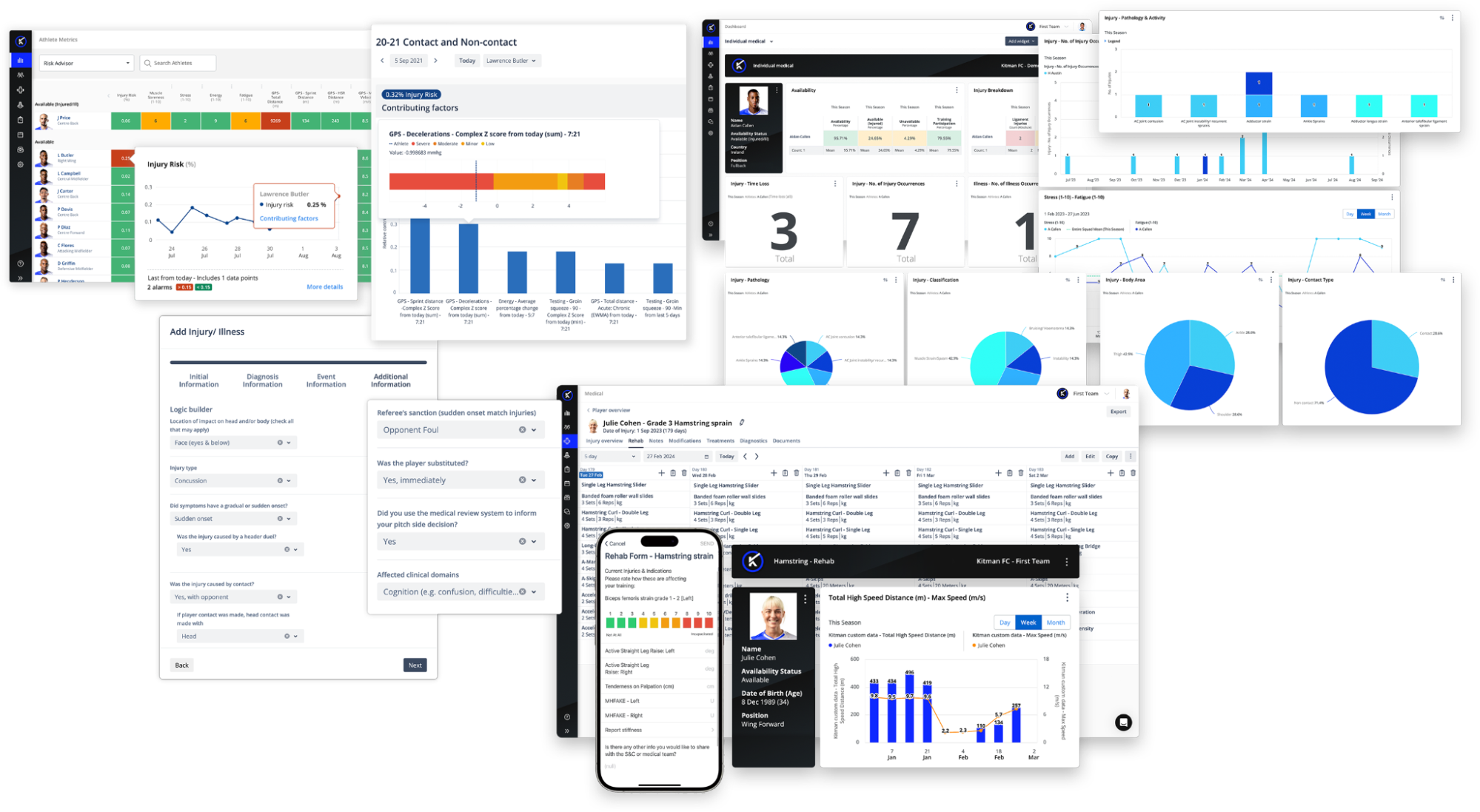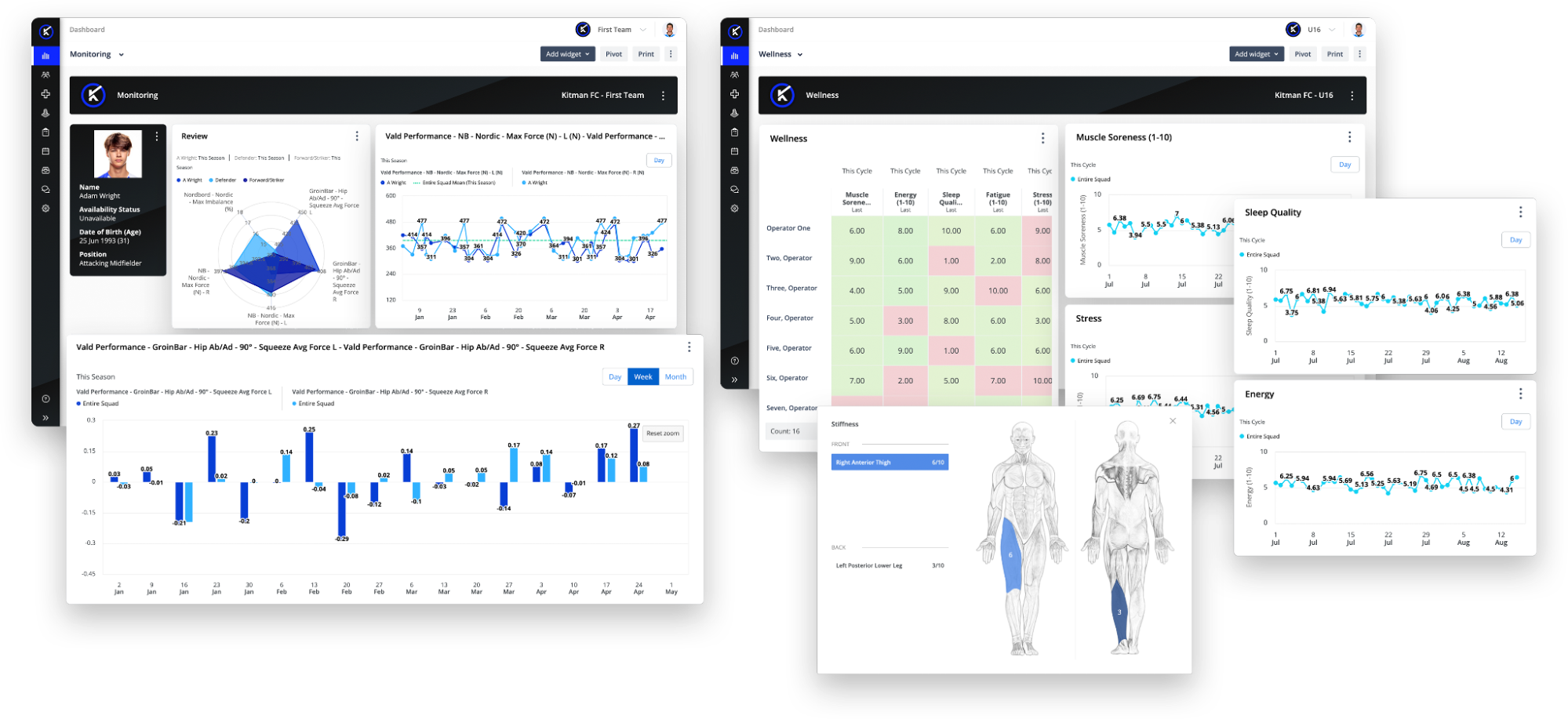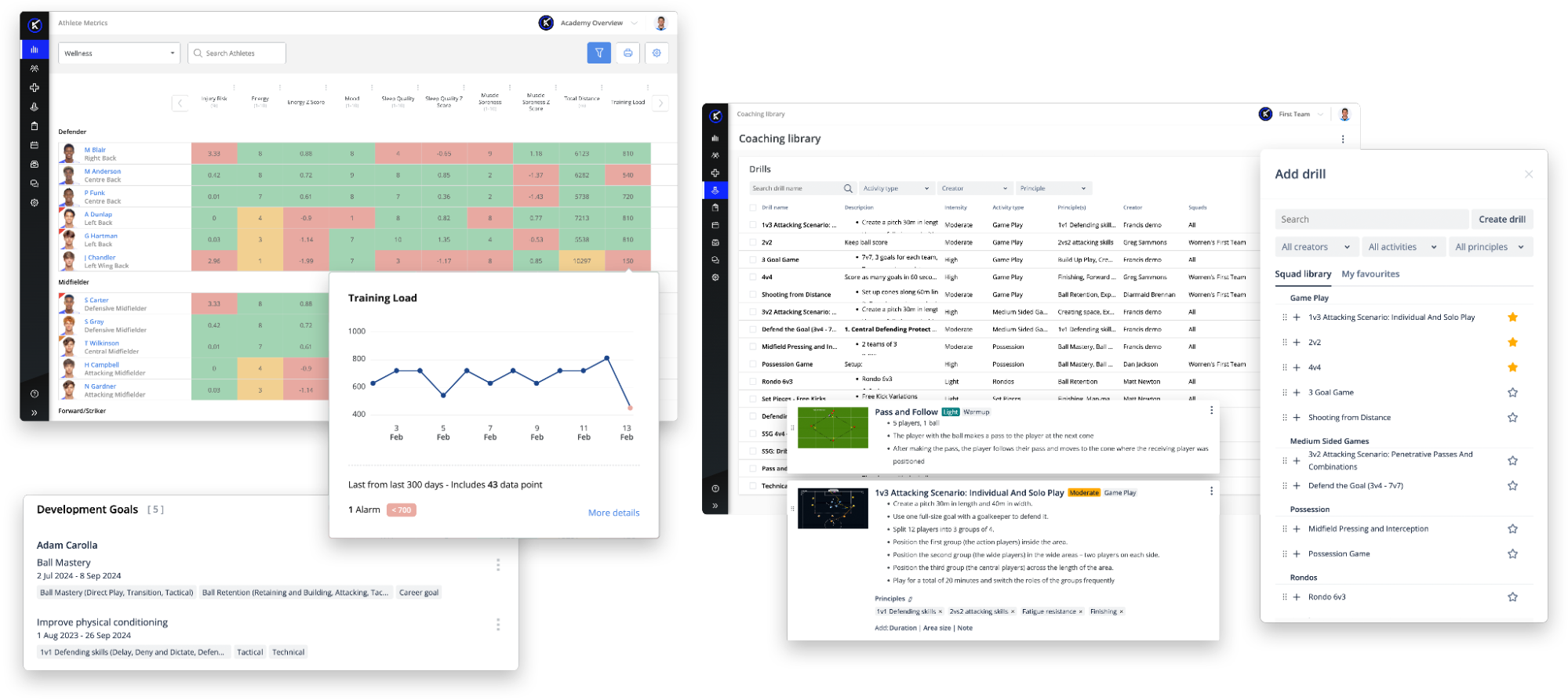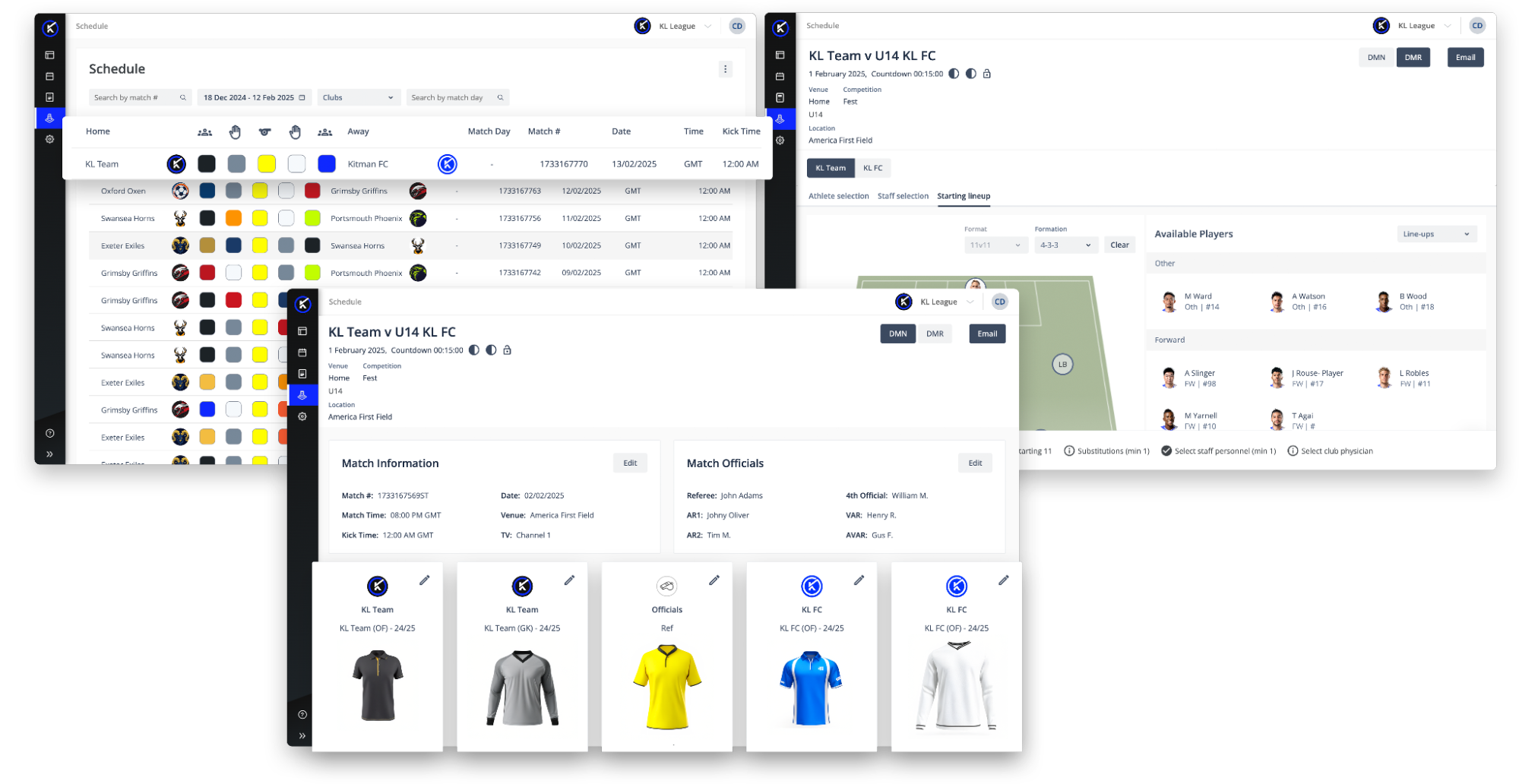Injury management software has evolved far beyond digital record-keeping. Today, leading organizations rely on unified data, configurable workflows, and actionable intelligence to keep athletes healthier, accelerate rehab, and align medical, performance, and coaching staff around a single trusted source of truth.
This guide explores what modern injury management software should deliver—and how Kitman Labs’ iP: Intelligence Platform turns those expectations into measurable results.
What Teams Should Expect from Injury Management Software
The real measure isn’t features—it’s outcomes: fewer injuries, faster recoveries, safer return to play.
High-performing teams look for:
- Centralized athlete health data – Evaluations, diagnostics, imaging, treatments, and notes in one secure system with audit trails.
- Configurable workflows – Evaluation, rehab, care plans, daily status, and return to play processes designed to ensure nothing falls through the cracks.
- Real-time risk and availability signals – Context-rich insights combining medical, training load, and wellness data.
- Automated communication – Alerts, handoffs, and daily reports that eliminate back-and-forth and reduce admin time.
- Injury surveillance & reporting – Track patterns, quantify time-loss, and demonstrate impact to leadership.
- Security & compliance – Role-based access aligned with privacy standards and league requirements.
- Third-party integrations – Seamlessly ingest data from healthcare systems, diagnostics, and performance technologies—no copy-paste required. Streamline data entry with automation and dictation tools to save time and reduce human error.
How Kitman Labs’ iP: Intelligence Platform Delivers
iP: Intelligence Platform unifies medical and performance data across the organization—turning injury management into proactive, data-driven care. Teams can enable Solutions that scale with their needs.
Performance Medicine
- Centralized medical record: Complete injury and illness history, SOAP notes, medications, imaging, and treatment plans, all captured in one secure, auditable record.
- Rehabilitation and return to play tracking: End-to-end visibility from initial assessment through clearance, with milestones, objective criteria, and recovery timelines shared across departments.
- Daily availability: Real-time “available,” “modified,” or “unavailable” status updates—automatically reflected in training and selection workflows.
- Injury surveillance & reporting: Standardized definitions, dashboards, and automated epidemiology reports to identify patterns and guide prevention strategies.
- Logic Builder: Design, automate, and iterate on medical workflows with no-code automation. Embed business logic and research structures into your workflows, enabling conditional, contextual data collection with built-in consent management, triggers, and KPIs that mirror your protocols.
- Risk Advisor (feature add-on): Uses machine learning to identify elevated injury risks and uncover the underlying factors driving them. When combined with Performance Optimization, teams can integrate workload, wellness, and history data to highlight athletes who need proactive intervention.
- Communication & documentation: Automatic notifications, shared notes, and real-time collaboration between medical and performance staff ensure continuity of care.

Value delivered: Faster, more consistent care; defensible return-to-play decisions; measurable reductions in preventable injuries and higher data quality to support short- and long-term analysis.
Performance Optimization
- Training load & wellness integration: GPS, force plate data, HR/HRV, RPE, and screenings unified with medical context for a complete view of stress, fatigue, and recovery.
- Readiness dashboards: Role-specific insights showing who can train, at what intensity, and why—supporting safe, individualized decisions.
- Preventive insights: Automated alerts for spikes, monotony, and chronic load trends—flagging risk before it becomes injury.
- Recovery & fatigue tracking: Post-session recovery metrics and cumulative workload trends that signal when to scale or modify training.
- Injury risk detection & RTP context: Merge performance, load, and wellness data with medical records to validate return-to-play readiness and ongoing workload exposure.
- Cross-department collaboration: Shared athlete profiles, permissions, and notes keep medical, S&C, and coaching staff aligned on status and plan.
- Performance benchmarking: Compare pre- and post-injury metrics to ensure full recovery and prevent re-injury.

Value delivered: Reduced soft-tissue risk, optimized training availability, and seamless transition from rehab to full performance.
Beyond Injury Management: A Connected Ecosystem
While the Performance Medicine and Performance Optimization Solutions form the foundation of modern injury management, many organizations extend their approach with additional Solutions in iP: Intelligence Platform.
Coaching & Development – Align rehab goals with long-term player development, ensuring athletes return not only healthy but on track in their overall progression plan. Reintegration becomes part of their growth—not a reset.

League Operations – Standardize league-wide registration, fixture, discipline, and compliance workflows across clubs to enhance transparency, governance, and competition integrity. League-wide visibility enables smarter policy decisions, streamlined operations, and improved oversight of player welfare.

Together, these Solutions connect short-term recovery with long-term development—at both the club and league level—creating a continuous ecosystem for athlete health, performance, and progression.
Solving the Biggest Pain Points
Traditional injury management software stops at recording data. iP: Intelligence Platform goes further—uniting medical and performance data to deliver real-time availability, proactive risk insights, and secure, unified intelligence that transforms athlete care.
| Pain Point | Traditional Injury Management Software |
With iP: Intelligence Platform |
| Fragmented data | Siloed notes, load, and wellness data mean decisions are made with partial context. | Unified hub connecting medical and performance data for a complete picture. |
| Manual workflows | Email chains, duplicate entries, and missed handoffs slow response times and fragment communication. | Automated, logic-driven workflows eliminate manual steps, ensure seamless handoffs, and keep every stakeholder aligned in real time. |
| Subjective return to play | Clearance varies among practitioners, leading to inconsistency and increased risk. | RTP checklists and performance-linked milestones ensure objective, defensible clearance. |
| Reactive risk management | Injuries are only addressed after they occur; patterns surface too late. | Daily risk signals and trend reports highlight issues early, allowing staff to act proactively. |
| Hard-to-prove impact | Leadership sees the cost but lacks evidence of return; prevention remains invisible. | Dashboards show injury incidence, severity, days lost, and the impact of interventions. |
| Compliance risk | Sensitive medical data is spread across spreadsheets and unsecured apps. | Role-based access, audit logs, and certifications safeguard privacy and compliance. |
Turning Daily Decisions into Strategic Advantage
With iP: Intelligence Platform, every decision—from the morning availability check to return to play clearance—is powered by connected data, automated workflows, and real-time insight.
Teams eliminate the noise of disconnected tools and fragmented communication. Instead, they gain:
- One system, one audit trail, one truth—cutting admin time and confusion.
- Complete athlete context—medical, performance, and readiness data in one view.
- Scalability from first team to academy to league—consistent processes, shared standards, and secure oversight.
- Flexible configuration and modular deployment—so organizations of any scale can adopt the capabilities that fit their structure, workflows, and budget.
Implementation delivers value fast: start with availability and readiness views, integrate essential data sources, and track outcomes quarterly. The result? Fewer injuries, faster return to play, and measurable performance impact.
Ready to Modernize Injury Management?
If your injury management still relies on spreadsheets, emails, and PDFs, you’re making critical decisions with incomplete data. With iP: Intelligence Platform—and its Performance Medicine and Performance Optimization Solutions—you get a secure, unified system to reduce injuries, accelerate return to play, and align every stakeholder.
Contact us to discuss your injury management goals and the fastest path to value.




